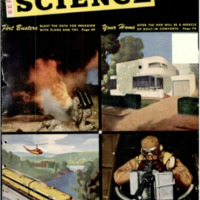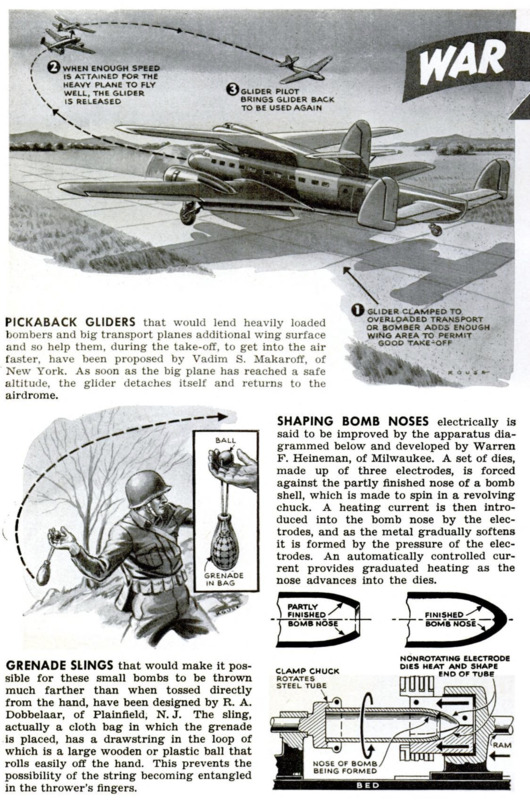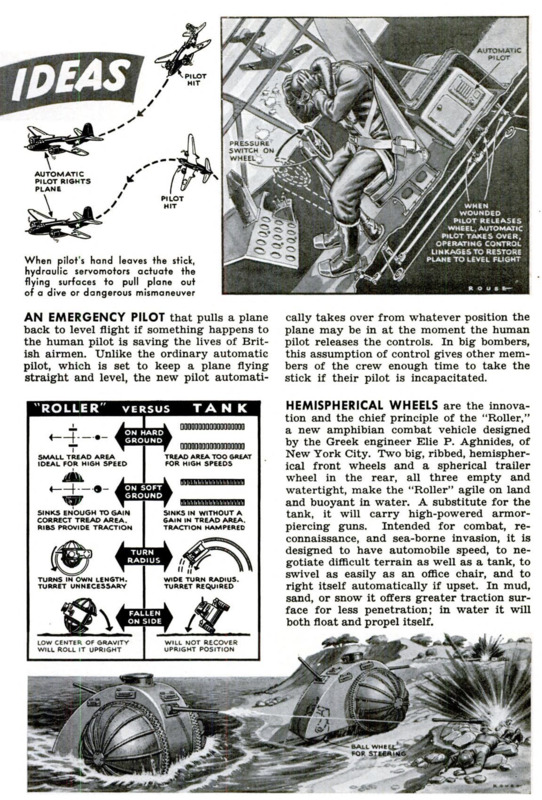War Ideas
Item
-
Title (Dublin Core)
-
War Ideas
-
Article Title and/or Image Caption (Dublin Core)
-
War Ideas
-
extracted text (Extract Text)
-
PICKABACK GLIDERS that would lend heavily loaded
bombers and big transport planes additional wing surface
and so help them, during the take-off, to get into the air
faster, have been proposed by Vadim S. Makaroff, of
New York. As soon as the big plane has reached a safe
altitude, the glider detaches itself and returns to the
airdrome.
SHAPING BOMB NOSES electrically is
said to be improved by the apparatus dia-
grammed below and developed by Warren
F. Heineman, of Milwaukee. A set of dies,
made up of three electrodes, is forced
against the partly finished nose of a bomb
shell, which is made to spin in a revolving
chuck. A heating current is then intro-
duced into the bomb nose by the elec-
trodes, and as the metal gradually softens
it is formed by the pressure of the elec-
trodes. An automatically controlled cur-
rent provides graduated heating as the
nose advances into the dies.
GRENADE SLINGS that would make it pos-
sible for these small bombs to be thrown
much farther than when tossed directly
from the hand, have been designed by R. A.
Dobbelaar, of Plainfield, N.J. The sling,
actually a cloth bag in which the grenade
is placed, has a drawstring in the loop of
which is a large wooden or plastic ball that
rolls easily off the hand. This prevents the
possibility of the string becoming entangled
in the thrower’s fingers.
AN EMERGENCY PILOT that pulls a plane
back to level flight if something happens to
the human pilot is saving the lives of Brit-
ish airmen. Unlike the ordinary automatic
pilot, which is set to keep a plane flying
straight and level, the new pilot automati-
cally takes over from whatever position the
plane may be in at the moment the human
pilot releases the controls. In big bombers,
this assumption of control gives other mem-
bers of the crew enough time to take the
stick if their pilot is incapacitated.
HEMISPHERICAL WHEELS are the innova-
tion and the chief principle of the “Roller,”
a new amphibian combat vehicle designed
by the Greek engineer Elie P. Aghnides, of
New York City. Two big, ribbed, hemispher-
ical front wheels and a spherical trailer
wheel in the rear, all three empty and
watertight, make the “Roller” agile on land
and buoyant in water. A substitute for the
tank, it will carry high-powered armor-
piercing guns. Intended for combat, re-
connaissance, and sea-borne invasion, it is
designed to have automobile speed, to ne-
gotiate difficult terrain as well as a tank, to
swivel as easily as an office chair, and to
right itself automatically if upset. In mud,
sand, or snow it offers greater traction sur-
face for less penetration; in water it will
both float and propel itself.
-
Language (Dublin Core)
-
eng
-
Date Issued (Dublin Core)
-
1943-09
-
pages (Bibliographic Ontology)
-
104-105
-
Rights (Dublin Core)
-
Public Domain (Google digitized)
-
Archived by (Dublin Core)
-
Matteo Ridolfi
-
Alberto Bordignon (Supervisor)
 Popular Science Monthly, v. 143, n. 3, 1943
Popular Science Monthly, v. 143, n. 3, 1943




